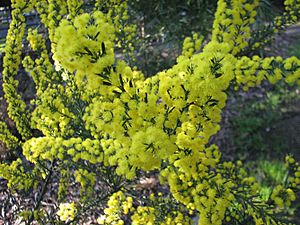Imbricate wattle facts for kids
Quick facts for kids Imbricate wattle |
|
|---|---|
 |
|
| Scientific classification | |
| Genus: |
Acacia
|
| Species: |
imbricata
|
 |
|
| Occurrence data from AVH | |
The Acacia imbricata, also known as the imbricate wattle, is a type of shrub. It is special because it is endemic to South Australia. This means it naturally grows only in South Australia and nowhere else in the world!
Contents
What Does the Imbricate Wattle Look Like?
This shrub usually grows to be between 1 and 2 meters (about 3 to 6.5 feet) tall. It has a dense, spreading shape. Its branches are smooth and look a bit like willow branches.
The plant has special leaf-like parts called phyllodes. These are not true leaves, but they do the same job. The phyllodes are dark green, straight, and grow close together. They can be up to 16 millimeters (about 0.6 inches) long and 2 millimeters (about 0.08 inches) wide.
Flowers and Branches
The imbricate wattle has bright yellow, round flowerheads. These flowers grow from where the phyllodes meet the stem. They can appear alone or in groups of two.
The plant's small branches, called branchlets, have strong angles and ribs below the phyllodes. This gives the plant a unique look.
Who Discovered the Imbricate Wattle?
The imbricate wattle was first officially described in 1858. This was done by Ferdinand von Mueller, who was a botanist for the Victorian Government. He wrote about it in his book Fragmenta Phytographiae Australiae.
Mueller's description was based on plants he found near Tumby Bay. This is how scientists give new plants their official names and descriptions.
Where Does the Imbricate Wattle Grow?
This wattle species has a small natural home. It lives in the southeastern part of the Eyre Peninsula in South Australia. You can find it from the Yeelanna–Ungarra road in the north down to areas like Koppio and Warunda in the south.
The imbricate wattle usually grows in sandy soils. It is often found in open woodlands, forests, or scrubland areas. These are places where trees and shrubs grow, but not too densely.

